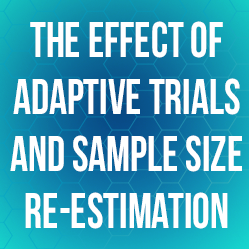In part 2/3 of this mini series, Head of Statistics at Statsols - Ronan Fitzpatrick - examines key trends in sample size determination which are being felt in trial design.
The Effect of Adaptive Trials and
Sample Size Re-estimation
In recent years there has been a major shift in clinical trial design in response to increasing trial cost, higher trial failure rates and increased computing power and expertise. One of these major shifts has been the continued evolution and usage of adaptive trial designs. While simpler adaptive designs such as group sequential designs and blinded sample size re-estimation have gained wide acceptance, it is only in the last decade that the Food & Drug Administration (FDA) and European Medicines Agency (EMA) has provided comprehensive guidance on appropriate adaptive designs in clinical trials. These agencies considered adaptive trials which can change study trial design choices such as treatment allocations, treatment arm addition and removal, primary endpoint, analysis methods, seamless phase designs and of course sample size re-estimation.

All of these adaptions have an effect on sample size determination since any change in a statistical or trial design assumption will also affect the sample size estimate. For example, a trial which can change the analysis method will likely need to make appropriate changes to the sample size at that switch. Thus these innovations are rapidly changing the way sample size is viewed and leading to a tighter link between the sample size, the trial plan and actual practical workings of the trial. This necessitates continuing research into the appropriate sample size for these designs, likely necessitating more complex sample size methods including those based on simulation.
The most integral adaption to sample size determination approaches is the continuing growth in sample size re-estimation. The usage of blinded re-estimation is already a key part of study design with methods such as internal pilot studies already being widely accepted. However, the usage of un-blinded sample size re-estimation is gathering momentum despite the worries regarding bias and chasing significance. A number of different approaches and alternative statistics have been suggested to allow for un-blinded re-estimation.
However, for late-stage trials, the methods with the most momentum are those which use conditional power to define an interim analysis as “promising” and based on this allow adjustment to bring the conditional power to the target power via increased sample size. The theory suggests that when a result is “promising” the standard test statistics from both the standard fixed term and group sequential tests can be usable without adjustment while still not inflating the overall error levels of the study. Another adaptive design which will likely see continued growth is seamless designs in early and late stage clinical trials with an associated growth in the methods and resources to estimate and re-estimate the sample size for these designs.
In the past, methods which have required smaller steps from established practice have often ended up winning out in practice and thus the adoption of the method may become more widely prevalent in clinical practice and beyond in the near future. However, these methods will only reach their full potential when the methods for these adaptions become easily and widely available in standard statistical packages and software. Overall, adaptive designs in clinical trial designs is undergoing significant growth. These designs are leading to a far more holistic approach to study planning than the set and forget fixed term trials which traditionally dominated. This evolution represents challenges to the traditional approach to sample size estimation but also opportunities to more fundamentally integrate sample size considerations into the whole of trial design in clinical trials and beyond.
References
Below you will find a selection of interesting papers and resources on the topics discussed in this mini series. These are only meant as an illustrative set of papers in the relevant fields and should not be considered a comprehensive summary of these areas.
- Bhatt, Deepak L., and Cyrus Mehta. "Adaptive designs for clinical trials."New England Journal of Medicine 375.1 (2016): 65-74.
- Bauer P, Koenig, F. “The reassessment of trial perspectives from interim data—a critical view.” Statistics in Medicine 25, (2006): 23-36.
- US Food and Drug Administration. “Guidance for Industry: Adaptive Designs for Medical Device Clinical Studies” (2016), Available at: http://www.fda.gov/downloads/medicaldevices/deviceregulationandguidance/guidancedocuments/ucm446729.pdf
- US Food and Drug Administration. “Draft Guidance for Industry: Adaptive Design Clinical Trials for Drugs and Biologics” (2010), Available at: http://www.fda.gov/downloads/Drugs/GuidanceComplianceRegulatoryInformation/Guidances/UCM201790.pdf
- Mehta, Cyrus R., and Stuart J. Pocock. "Adaptive increase in sample size when interim results are promising: a practical guide with examples."Statistics in medicine 30.28 (2011): 3267-3284.
- Shih, Weichung Joe. "Group sequential, sample size re‐estimation and two‐stage adaptive designs in clinical trials: a comparison." Statistics in Medicine 25.6 (2006): 933-941.
You can also read Part 1/3 Integrating Uncertainty in Parameter Estimates and Part 3/3 Wider Integration of Cost Considerations in Sample Size.




















No Comments Yet
Let us know what you think